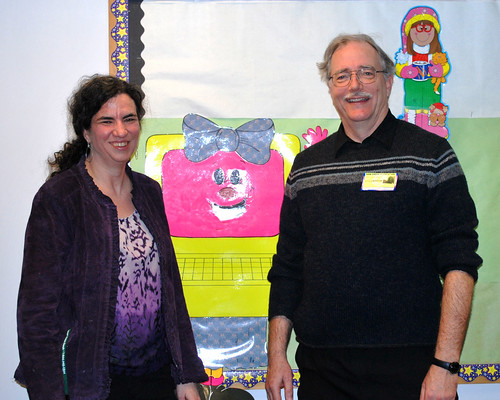
Drs. Rebecca Efroymson and Bill Hargrove held a recent science club meeting in Haw Creek Elementary School’s computer lab. (U.S. Forest Service/Stephanie Worley Firley)
When he was a child, Forest Service scientist Bill Hargrove burnt off his eyebrows making rocket fuel, blew up a sealed jar of cultured yeast and started a bathroom fire while doing sterile transfers for a carrot tissue culture. Fortunately, he survived his early scientific experiments and is now inspiring a new generation of young students.
Hargrove, a research ecologist with the Eastern Forest Environmental Threat Assessment Center, and his wife, Rebecca Efroymson, are pioneering an extramural science club for fourth and fifth graders at Haw Creek Elementary School in Asheville, N.C. Each monthly club meeting features real-life scientists who lead lively discussions and activities about diverse scientific topics.
During the first club meeting last year, students looked at living creatures found in drops of pond water through a light microscope—Hargrove’s own childhood microscope.
“I used to spend hours in junior high school looking at protozoa through that microscope. My family got used to having stinky jars of pond water on every available window sill,” Hargrove said.
While learning about the microscope, students also looked at toothpaste, sandpaper, salt crystals, and grooves in a phonograph record, an object that was not as familiar to them as Hargrove had hoped. Hargrove projected the images under the microscope onto a large screen so that all of the students could see them at the same time. Students also controlled a scanning electron microscope located in a different state over the Internet to observe many insect specimens that they had mailed weeks earlier to the national Bugscope project.
Science club activities go well beyond examining the microscopic world. During past meetings, students constructed simple robots that could move and follow a light source; explored rockets, airplanes and space, including outdoor rocket and airplane demos; and delved into electronics. Students have also surveyed archaeology, constructed pickle and lemon batteries, learned about biofuels and solar power, and have even touched human brains as part of a recent meeting focused on psychology, following a discussion about respectful conduct and ethics.
One might wonder why Hargrove and Efroymson — both busy researchers and the parents of two — commit their extremely limited spare time to the club. In short, they wish to share their passion for science with others. They hope to excite students about the possibilities of careers in science, especially those who are underrepresented in scientific fields, including women and minorities.
Hargrove, an entomologist by training and once a young shortwave and amateur radio enthusiast, explains that kids today belong to a ‘software generation’ and feels that free range tinkering with hardware and electronics is critically important for developing minds.
“I think that kids often don’t get any ‘feel’ for science,” he said. “But if they can experiment in a safe environment, they realize that science is just normal, regular stuff. No magic at all. Then the fear is gone, de-mystified, and they can get on with learning.”
No comments:
Post a Comment